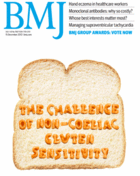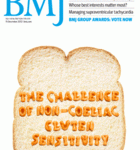 …..Is the title to the BMJ’s Editor’s Choice article this week (Dec 12th 2012) and whilst we in the Nutritional Therapy world find the concept that physicians still deny the empirical evidence of people recovering post gluten and often lactose excluding diets as NOT being indicative of there being a problem, Fiona Godlee does recognise a problem exists.[1]
…..Is the title to the BMJ’s Editor’s Choice article this week (Dec 12th 2012) and whilst we in the Nutritional Therapy world find the concept that physicians still deny the empirical evidence of people recovering post gluten and often lactose excluding diets as NOT being indicative of there being a problem, Fiona Godlee does recognise a problem exists.[1]
If you fancy hearing a short podcast on this subject, and can avoid shouting at the speakers in frustration, do look on the right side of the main web page screen and click on Latest Podcast – play. http://www.bmj.com/ If it is not on the front page, then click on the ‘see more’ text at the top of the latest podcast image and search.
The medicalisation of gluten sensitivity is both a positive and a negative effect, the increased clarification of allergy, sensitivity and coeliac will assist all clinicians in diagnosis, albeit that the primary intervention is still the dietary exclusion of gluten containing grains.
This simple chart extracted from the NEJM will help to summarise the key clinical and pathological differences between these three groups.[2]
Many people report gluten sensitivity and have a clinical response to gluten free diet in the absence of any serologic or histologic evidence of coeliac disease.
Yet the frequency, pathophysiology and natural history of gluten sensitivity and whether it has a causal or correlative relationship with coeliac disease remain to be elucidated. Symptom benefits after exclusion cannot be directly attributed to gluten sensitivity, allergy or coeliac, as apart from any placebo effects there may be an incorrect assumptive explanation, that requires further clarity – although people who know they feel better rarely care as long as they know what to do.
| Clinical and Pathogenic Differences among Coeliac Disease, Gluten Sensitivity and Wheat Allergy | |||
| Variable | Coeliac Disease | Gluten Sensitivity | Wheat Allergy |
| Interval between exposure to gluten and onset of symptoms | Weeks to years | Hours to days | Minutes to hours |
| Pathogenesis | Autoimmunity (innate and adaptive immunity) | Possibly innate immunity | Allergenic immune response |
| HLA | Restricted to HLA-DQ2 or HLA-DQ8 (in approximately 97% of positive cases) | Not restricted to HLA-DQ2 or HLA-DQ8 (HLA-DQ2 positive, HLA-DQ8 positive or both in 50% of patients) | Not restricted to HLA-DQ2 or HLA-DQ8 (HLA-DQ2 positive, HLA-DQ8 positive or both in 35-40% of patients, similar to general population) |
| Autoantibodies | Almost always present | Always absent | Always absent |
| Enteropathy | Almost always present | Always Absent (slight increase in the intraepithelial lymphocyte count) | Always absent (eosinophil’s in the lamina propria) |
| Symptoms | Both intestinal and extraintestinal; gastrointestinal symptoms not distinguishable from those of gluten sensitivity or wheat allergy | Both intestinal and extraintestinal; gastrointestinal symptoms not distinguishable from those of gluten sensitivity or wheat allergy | Both intestinal and extraintestinal; gastrointestinal symptoms not distinguishable from those of gluten sensitivity or wheat allergy |
| Complications | Co-existing conditions; long-term complications | Absence of coexisting conditions and long-term complications | Absence of coexisting conditions; short-term complications (including anaphylaxis) |
References
[1] Godlee, F. Gluten sensitivity: real or not? BMJ 2012;345:e8450 (Published 12 December 2012) View Article
[2] Fasano A, Ctassi C. Celiac Disease. NEJM 367;25 Dec 20, 2012.





